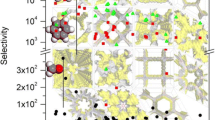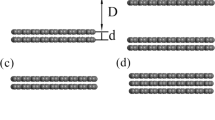Abstract
Adsorption of polar molecules, such as formaldehyde, ammonia, and water, is profoundly affected by both the pore structure and the functional groups (FGs) of an adsorbent. Investigating the effects of pore structures and FGs separately is important but intractable for experiments and the conventional modeling. Molecular simulation provides a powerful tool to probe the adsorption mechanism by extracting abundant microscopic details. In present study, we have conducted a Monte Carlo simulation of formaldehyde, ammonia, and water, aiming to offer new insights into the capture of polar indoor air pollutants by adsorption. Upon the adsorption isotherms of formaldehyde and ammonia in the carbon nanopores at sub-ppm level, the effects of pore size and the FGs were separately investigated using the isosteric heats at zero loading as a measure of guest–host interaction. Based on the analysis of the pairwise potential energies of formaldehyde, ammonia, and water as well as their cluster-mediated adsorption mechanisms, we proposed that water may act as strong anchors for capturing formaldehyde and ammonia, with the premise that water does not condense and block the pore. Further discussion on the development of effective water-resistant adsorbent for the polar indoor air pollutants was presented.
Similar content being viewed by others
References
ASHRAE (2016). ANSI/ASHRAE Standard 62.1. Ventilation for Acceptable Indoor Air Quality. Atlanta, GA, USA: American Society of Heating, Refrigerating, and Air Conditioning Engineers.
Bai Z, Dong Y, Wang Z, Zhu T (2006). Emission of ammonia from indoor concrete wall and assessment of human exposure. Environment International, 32: 303–311.
Berendsen HJC, Grigera JR, Straatsma TP (1987). The missing term in effective pair potentials. The Journal of Physical Chemistry, 91: 6269–6271.
Bojan MJ, Steele WA (1988). Computer simulation of physisorption on a heterogeneous surface. Surface Science, 199: L395–L402.
Bojan MJ, Steele WA (1993). Computer simulation of physical adsorption on stepped surfaces. Langmuir, 9: 2569–2575.
Bottani EJ, Tascón JMD (2008). Adsorption by Carbons. Amsterdam: Elsevier Science.
Briggs JM, Nguyen TB, Jorgensen WL (1991). Monte Carlo simulations of liquid acetic acid and methyl acetate with the OPLS potential functions. The Journal of Physical Chemistry, 95: 3315–3322.
Cai W, Piner RD, Stadermann FJ, Park S, Shaibat MA, et al. (2008). Synthesis and solid-state NMR structural characterization of 13C-labeled graphite oxide. Science, 321: 1815–1817.
Carter EM, Katz LE, Speitel GE, Jr, Ramirez D (2011). Gas-phase formaldehyde adsorption isotherm studies on activated carbon: correlations of adsorption capacity to surface functional group density. Environmental Science & Technology, 45: 6498–6503.
Cogliano VJ, Grosse Y, Baan RA, Straif K, Secretan MB, et al. (2005). Meeting report: summary of IARC monographs on formaldehyde, 2-butoxyethanol, and 1- tert -butoxy-2-propanol. Environmental Health Perspectives, 113: 1205–1208.
Cychosz KA, Guillet-Nicolas R, García-Martínez J, Thommes M (2017). Recent advances in the textural characterization of hierarchically structured nanoporous materials. Chemical Society Reviews, 46: 389–414.
de Falco G, Li W, Cimino S, Bandosz TJ (2018). Role of sulfur and nitrogen surface groups in adsorption of formaldehyde on nanoporous carbons. Carbon, 138: 283–291.
Du Z, Mo J, Zhang Y (2014). Risk assessment of population inhalation exposure to volatile organic compounds and carbonyls in urban China. Environment International, 73: 33–45.
Düren T, Bae Y-S, Snurr RQ (2009). Using molecular simulation to characterise metal–organic frameworks for adsorption applications. Chemical Society Reviews, 38: 1237–1247.
Erickson K, Erni R, Lee Z, Alem N, Gannett W, Zettl A (2010). Determination of the local chemical structure of graphene oxide and reduced graphene oxide. Advanced Materials, 22: 4467–4472.
Franklin RE (1951). Crystallite growth in graphitizing and non-graphitizing carbons. Proceedings of the Royal Society of London Series A Mathematical and Physical Sciences, 209: 196–218.
Frenkel D, Smit B (2002). Understanding Molecular Simulation—From Algorithms to Applications. London: Academic Press.
GB/T 18883 (2002). GB/T 18883-2002: Indoor Air Quality Standard. Beijing: China Standard Press. (in Chinese)
Hiki S, Mawatari K, Aota A, Saito M, Kitamori T (2011). Sensitive gas analysis system on a microchip and application for on-site monitoring of NH3 in a clean room. Analytical Chemistry, 83: 5017–5022.
Hodgson AT, Beal D, McIlvaine JER (2002). Sources of formaldehyde, other aldehydes and terpenes in a new manufactured house. Indoor Air, 12: 235–242.
Huang Y, Lee SC, Ho KF, Ho SSH, Cao N, Cheng Y, Gao Y (2012). Effect of ammonia on ozone-initiated formation of indoor secondary products with emissions from cleaning products. Atmospheric Environment, 59: 224–231.
Jorgensen WL, Tirado-Rives J (1988). The OPLS [optimized potentials for liquid simulations] potential functions for proteins, energy minimizations for crystals of cyclic peptides and crambin. Journal of the American Chemical Society, 110: 1657–1666.
Jorgensen WL, Maxwell DS, Tirado-Rives J (1996). Development and testing of the OPLS all-atom force field on conformational energetics and properties of organic liquids. Journal of the American Chemical Society, 118: 11225–11236.
Kelly TJ, Smith DL, Satola J (1999). Emission rates of formaldehyde from materials and consumer products found in California homes. Environmental Science & Technology, 33: 81–88.
Kristóf T, Vorholz J, Liszi J, Rumpf B, Maurer G (1999). A simple effective pair potential for the molecular simulation of the thermodynamic properties of ammonia. Molecular Physics, 97: 1129–1137.
Lee KJ, Miyawaki J, Shiratori N, Yoon S-H, Jang J (2013). Toward an effective adsorbent for polar pollutants: Formaldehyde adsorption by activated carbon. Journal of Hazardous Materials, 260: 82–88.
Li S, Banyasz J, Parrish M, Lyons-Hart J, Shafer K (2002). Formaldehyde in the gas phase of mainstream cigarette smoke. Journal of Analytical and Applied Pyrolysis, 65: 137–145.
Li Q, Jiang J, Cai S, Zhou W, Wang S, Duan L, Hao J (2016). Gaseous ammonia emissions from coal and biomass combustion in household stoves with different combustion efficiencies. Environmental Science & Technology Letters, 3: 98–103.
Liu L, Tan SJ, Horikawa T, Do DD, Nicholson D, Liu J (2017). Water adsorption on carbon - A review. Advances in Colloid and Interface Science, 250: 64–78.
Liu L, Liu J, Pei J (2018a). Towards a better understanding of adsorption of indoor air pollutants in porous media—From mechanistic model to molecular simulation. Building Simulation, 11: 997–1010.
Liu L, Zeng Y, Do DD, Nicholson D, Liu J (2018b). Development of averaged solid–fluid potential energies for layers and solids of various geometries and dimensionality. Adsorption, 24: 1–9.
Liu L, Liu J, Zeng Y, Tan SJ, Do DD, Nicholson D (2019a). Formaldehyde adsorption in carbon nanopores–New insights from molecular simulation. Chemical Engineering Journal, 370: 866–874.
Liu L, Zeng Y, Tan SJ, Xu H, Do DD, Nicholson D, Liu J (2019b). On the mechanism of water adsorption in carbon micropores–A molecular simulation study. Chemical Engineering Journal, 357: 358–366.
Loh MM, Levy JI, Spengler JD, Houseman EA, Bennett DH (2007). Ranking cancer risks of organic hazardous air pollutants in the United States. Environmental Health Perspectives, 115: 1160–1168.
Mooney DA, Müller-Plathe F, Kremer K (1998). Simulation studies for liquid phenol: properties evaluated and tested over a range of temperatures. Chemical Physics Letters, 294: 135–142.
Nomura A, Jones CW (2013). Amine-functionalized porous silicas as adsorbents for aldehyde abatement. ACS Applied Materials & Interfaces, 5: 5569–5577.
Pacilé D, Meyer JC, Fraile Rodríguez A, Papagno M, Gómez-Navarro C, Sundaram RS, Burghard M, Kern K, Carbone C, Kaiser U (2011). Electronic properties and atomic structure of graphene oxide membranes. Carbon, 49: 966–972.
Petit C, Bandosz TJ (2010). Enhanced adsorption of ammonia on metal-organic framework/graphite oxide composites: analysis of surface interactions. Advanced Functional Materials, 20: 111–118.
Prasetyo L, Do DD, Nicholson D (2018). A coherent definition of Henry constant and isosteric heat at zero loading for adsorption in solids–An absolute accessible volume. Chemical Engineering Journal, 334: 143–152.
Salthammer T, Mentese S, Marutzky R (2010). Formaldehyde in the indoor environment. Chemical Reviews, 110: 2536–2572.
Sarigiannis DA, Karakitsios SP, Gotti A, Liakos IL, Katsoyiannis A (2011). Exposure to major volatile organic compounds and carbonyls in European indoor environments and associated health risk. Environment International, 37: 743–765.
Smit B, Maesen TLM (2008). Molecular simulations of zeolites: adsorption, diffusion, and shape selectivity. Chemical Reviews, 108: 4125–4184.
Steele WA (1973). The physical interaction of gases with crystalline solids: I. Gas-solid energies and properties of isolated adsorbed atoms. Surface Science, 36: 317–352.
Sundblad B-M, Larsson B-M, Acevedo F, Ernstgård L, Johanson G, Larsson K, Palmberg L (2004). Acute respiratory effects of exposure to ammonia on healthy subjects. Scandinavian Journal of Work, Environment & Health, 30: 313–321.
Suresh S, Bandosz TJ (2018). Removal of formaldehyde on carbon - based materials: A review of the recent approaches and findings. Carbon, 137: 207–221.
Thevenet F, Debono O, Rizk M, Caron F, Verriele M, Locoge N (2018). VOC uptakes on gypsum boards: Sorption performances and impact on indoor air quality. Building and Environment, 137: 138–146.
Tomoto T, Moriyoshi A, Sakai K, Shibata E, Kamijima M (2009). Identification of the sources of organic compounds that decalcify cement concrete and generate alcohols and ammonia gases. Building and Environment, 44: 2000–2005.
Wick CD, Stubbs JM, Rai N, Siepmann JI (2005). Transferable potentials for phase equilibria. 7. Primary, secondary, and tertiary amines, nitroalkanes and nitrobenzene, nitriles, amides, pyridine, and pyrimidine. The Journal of Physical Chemistry B, 109: 18974–18982.
WHO (2010). Selected pollutants: WHO guideline for indoor air quality. World Health Organization.
Zeng Y, Prasetyo L, Nguyen VT, Horikawa T, Do DD, Nicholson D (2015). Characterization of oxygen functional groups on carbon surfaces with water and methanol adsorption. Carbon, 81: 447–457.
Zeng Y (2016). Fundamental study of adsorption and desorption process in porous materials with functional groups. PhD Thesis, The University of Queensland, Australia.
Zhang J, Smith KR (1999). Emissions of carbonyl compounds from various cookstoves in China. Environmental Science & Technology, 33: 2311–2320.
Acknowledgements
The research was financially supported by The National Key Research and Development Program of China, “The Study of Formation and Control of Atmospheric Pollution” (No. 2017YFC0211500).
Author information
Authors and Affiliations
Corresponding author
Rights and permissions
About this article
Cite this article
Zhang, D., Liu, J. & Liu, L. On the capture of polar indoor air pollutants at sub-ppm level—A molecular simulation study. Build. Simul. 13, 989–997 (2020). https://doi.org/10.1007/s12273-020-0655-9
Received:
Revised:
Accepted:
Published:
Issue Date:
DOI: https://doi.org/10.1007/s12273-020-0655-9




